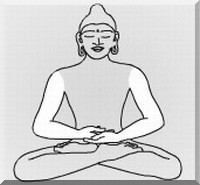|
MUDRA DHYANA
The Dhyana mudra may be made
with one or both hands. When made with a
single hand the left one is placed in
the lap, while the right may be engaged
elsewhere. The left hand making the
Dhyana mudra in such cases symbolizes
the female left-hand principle of
wisdom. Ritual objects such as a text,
or more commonly an alms bowl
symbolizing renunciation, may be placed
in the open palm of this left hand.
This gesture expresses overcoming the world of appearance
through enlightenment, as well as the enlightened state of
mind for which samsara and nirvana are one.
When made with both hands, the hands are generally held
at the level of the stomach or on the thighs. The right hand
is placed above the left, with the palms facing upwards, and
the fingers extended. In some cases the thumbs of the two
hands may touch at the tips, thus forming a mystic triangle.
The esoteric sects obviously attribute to this triangle a
multitude of meanings, the most important being the
identification with the mystic fire that consumes all
impurities. This triangle is also said to represent the
Three Jewels of Buddhism, mentioned above, namely the Buddha
himself, the Good Law and the Sangha. |

WORLD RELIGIONS
COMPARED
WORLD
RELIGIONS CLIPART
WORLD
RELIGIONS HOME
HINDUISM HOME
MUDRA HOME |
The Dhyana mudra is
the mudra of meditation, of concentration on the Good law, and of
the attainment of spiritual perfection. According to tradition, this
mudra derives from the one assumed by the Buddha when meditating
under the pipal tree before his Enlightenment. This gesture was also
adopted since time immemorial, by yogis during their meditation and
concentration exercises. It indicates the perfect balance of
thought, rest of the senses, and tranquillity.
This is the most common mudra used to depict the
Buddha when meditating under the Bodhi tree before his
Enlightenment. This mudra has been widely adopted by yogis and
various practitioners during meditation and concentration exercises
and it indicates perfect balance of thought, rest of the senses and
tranquility. The Gesture of Meditation is also showed with a
beggingbowl, but not with an other kind of bowl.
Variants: Samadhi, Yoga Mudra, Zenjou-in
(Japan).
The back of the right hand rests
on the palm of the other in such a way that the tips of the thumbs
lightly touch one another.
The hands rest in the lap. The right
hand,
resting on top, symbolizes the state of enlightenment;
the
other hand, resting below, the world of appearance.
In a special form of this mudra,
the middle, ring,
and little fingers of both hands lie on top one
another
and the thumbs and index finger of each hand,
touching each
other, form a circle,
which here also symbolizes the world of
appearance and the true nature of reality.
